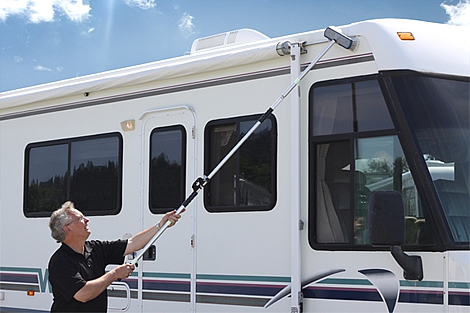
Few things in the world are supposed to be as harmless as a
cleaner. Cleaners, after all, are there for one thing and one thing only: to
improve an object’s cleanliness and appearance.
So why do so many RV cleaners seem to do so much more harm
than good?
It’s a sorry state of affairs when the consumer has to
wonder about a cleaner doing more damage than
good. But it turns out many cleaners aren’t as inert as most people would
prefer. Whether they damage the environment or damage the quality of your RV
exterior, it’s important to know whether or not your particular RV cleaner is
about to do more harm than good. Here are some of our favorite “clues” to tell
in advance:
- Non-biodegradable
cleaners have an obvious harmful
effect—maybe not on your RV itself, but on the environment. And that’s even
worse. When you harm your own RV, at least you aren’t making life more
miserable for everyone else. When you harm the environment, however, you can’t
say the same—which is why it’s important to search for an RV cleaner that says,
in plain print, that it is “biodegradable” right on the label. If you can’t
find that, keep looking for your ideal RV cleaner. - Phosphates
are a potential problem because of how they react with other substances.
Trisodium phosphate, in fact, was once one of the most ubiquitous cleaning
substances there were, until it was discovered that it can potentially do
damage to items like metal fixtures. Needless to say, that’s not exactly a good
thing when you want to use one RV cleaner to clean your entire RV—including the
metal fixtures. Look for non-phosphate formulas. - Smearing
and discoloration are two big problems when you work with sub-par RV
cleaners. After you rinse and dry your RV exterior using a different cleaner
for the first time, wait a little bit and then inspect the RV for these
problems later on. If you spot anything that’s new, then you have an idea that
your RV cleaner—while it might make
your RV clean—isn’t doing anything to improve the appearance of your exterior. - Multiple
cleaners are problems, too, even if they work effectively. Why? Because
they take time away from the process. You’ll want an “all-in-one” RV cleaner
that can handle metal and fiberglass alike. Anything else doesn’t only add to
storage space for all of those cleaning products, but is actually more
expensive.
The latter point means you’ll want an RV cleaner that
possesses all of the qualities we just wrote about, and it so happens that Suds fits the bill. It’s a non-phosphate
and an environmentally safe formula that will leave your RV cleaner fresh and
clean without discoloring or damaging your metal fixtures. And it’s all available in one bottle, which means that cleaning your RV
exterior doesn’t have to be a chore—just put on some tunes and take a Saturday
afternoon and you’ll have a fresh, clean, and attractive RV.

